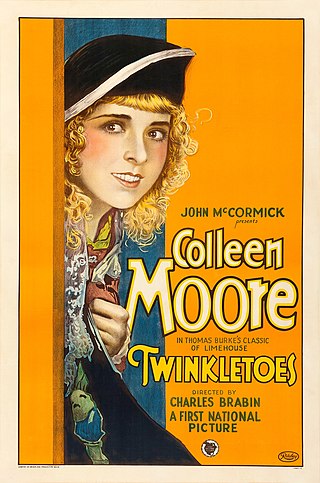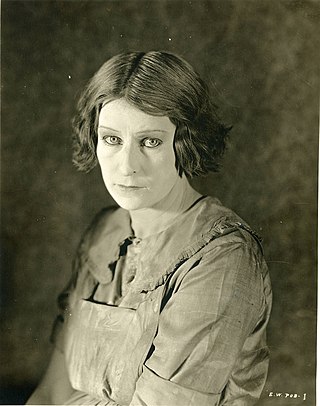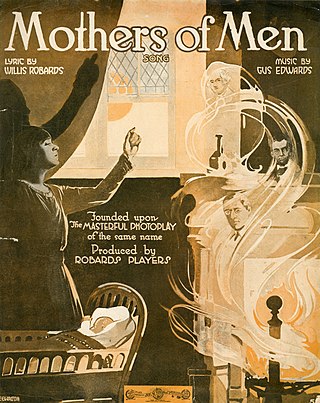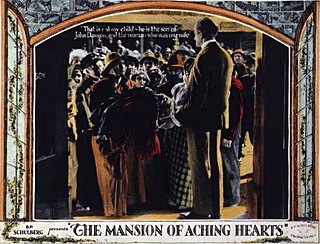
It is a 1927 American silent film directed by Clarence G. Badger and Josef von Sternberg, and starring Clara Bow. It is based on the serialised novella of the same name, republished in "It" and Other Stories (1927), by Elinor Glyn, who adapted the story and appears in the film as herself.

Fannie Dorothy Davenport was an American actress, screenwriter, film director, and producer.

Forever is a 1921 American silent romance film, also known as Peter Ibbetson, that was written by Ouida Bergère and directed by George Fitzmaurice. It was adapted from George du Maurier's 1891 novel Peter Ibbetson, which was made into a play of the same name by John N. Raphael.

The Road to Ruin is a 1934 pre-Code exploitation film directed by Dorothy Davenport, under the name "Mrs. Wallace Reid", and Melville Shyer, and written by Davenport with the uncredited contribution of the film's producer, Willis Kent. The film, now in the public domain, portrays a young woman whose life is ruined by sex and drugs.

Across to Singapore is a 1928 American silent romantic drama film directed by William Nigh, and starring Ramon Novarro, Joan Crawford and Ernest Torrence. The plot involves a love triangle between a woman and two brothers, set on board ship and in Singapore. The screenplay was written by Ted Shane based on the novel All the Brothers Were Valiant by Ben Ames Williams.

Ruth Clifford was an American actress of leading roles in silent films whose career lasted from that era into the television era.

The Red Lily is a 1924 American silent drama film directed by Fred Niblo and starring Ramon Novarro, Enid Bennett, and Wallace Beery. A print of the film exists.

The Place Beyond the Winds is a 1916 American silent drama film directed by Joe De Grasse, and starring Lon Chaney, Gretchen Lederer and Dorothy Phillips. It was written by Ida May Park, based on the novel by Harriet T. Comstock. The director De Grasse also played a role in the film. The film's original working title was Mansion of Despair. A still exists showing Chaney in the role of Jerry Jo, the homeless man.

Priscilla Bonner was an American silent film actress who specialized in portraying virginal, innocent heroines.

Twinkletoes is a 1926 American silent romantic drama film directed by Charles Brabin and starring Colleen Moore. The film, as with most of Moore's vehicles at this time, was produced by her husband John McCormick with the couple distributing through Moore's resident studio First National. This film is one of Moore's surviving films from the late silent era and is available on DVD.

Broken Laws is a 1924 American silent drama film directed by Roy William Neill, remarkable for the appearance of Dorothy Davenport, who is billed as "Mrs. Wallace Reid".

Nellie Bly Baker was an American actress active in the silent film era and early sound films, mostly playing minor roles. She is often confused with the journalist Nellie Bly (1864–1922). Baker's career as an actress took place from 1921 to 1934, and she performed in 13 films. She was never the star or had the main role in any films, playing minor or supporting characters. Many of these films were made by Associated First National Pictures, First National Pictures and Metro-Goldwyn-Mayer Pictures. Most of the films she performed in were silent.
The False Alarm is a 1926 American silent drama film directed by Frank O'Connor and starring Ralph Lewis, Dorothy Revier, and John Harron.

The Devil's Bondwoman is a 1916 American silent Melodrama directed by Lloyd B. Carleton. The film was based on the story by F. McGrew Willis and scenarized by Maie B. Havey and Fred Myton. The movie features Dorothy Davenport and Emory Johnson and employed the same cast seen in other Red Feather films, e.g., Barriers of Society, Black Friday.

Barriers of Society is a 1916 American silent drama film directed by Lloyd B. Carleton. Universal based the film on the story written by Clarke Irvine and adapted for the screen by Fred Myton. The feature film stars Dorothy Davenport, Emory Johnson, and an all-star cast of Universal contract players.

A Yoke of Gold is a 1916 American silent black and white melodrama directed by Lloyd B. Carleton and starring Dorothy Davenport and Emory Johnson. Based on an original story by Rob Wagner, it is a period piece set in the early days of the California missions.

Doctor Neighbor is a 1916 American silent feature film black and white melodrama. The film was directed by Lloyd B. Carleton. It stars Hobart Bosworth and pairs Dorothy Davenport and Emory Johnson in leading roles.

Mothers of Men is a 1917 silent film directed by Willis Robards, promoting woman's suffrage. The seven-reel drama is considered lost. A five-reel re-edited version also directed by Robards was released in 1921—following ratification of the Nineteenth Amendment—under the title Every Woman's Problem. This version survives through a single 35mm print preserved by the British Film Institute. The 1921 re-release was restored in 2016, in a collaboration between the BFI and the San Francisco Silent Film Festival.

The Mansion of Aching Hearts is a lost 1925 American silent drama film directed by James P. Hogan and starring Ethel Clayton, Barbara Bedford, and Priscilla Bonner.

Love and Glory is a 1924 American silent drama film directed by Rupert Julian and starring Charles de Rochefort, Wallace MacDonald, and Madge Bellamy.




















